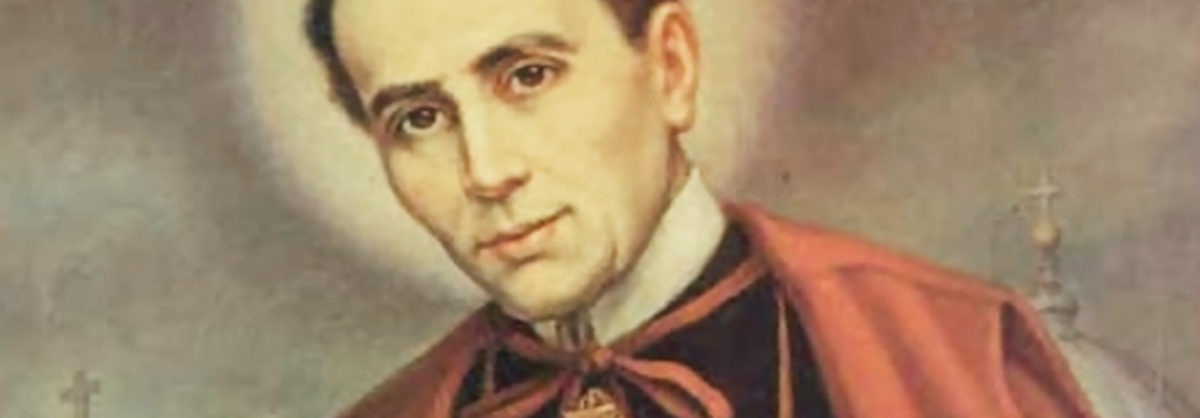Are you familiar with St. John Neumann, whose feast day we celebrate on January 5? I must confess that not too long ago, I was confused about exactly who St. John Neumann was. Because of the news coverage, I knew about St. John Henry Newman, the recently canonized English theologian and Cardinal, but I got the two men’s similar names mixed up in my mind.
When I asked for more information about who St. John Neumann was on Twitter, many of my Catholic friends in Philadelphia were happy to educate me and share photos of their visits to his shrine, venerated body and all.
St. John Neumann (1811-1860) was 10 years old and still living in Bohemia (now in the Czech republic) the year St. Elizabeth Ann Seton died (1774-1821) so they never crossed paths, but these two great saints are each an integral part of the history of the American Church, especially with regard to the impact they’ve had on Catholic education.
St. John Neumann had completed his studies, but was not even ordained a priest yet when he set sail for America, eager to serve the German-speaking Catholic population in Philadelphia. After a journey from France that lasted 40 days, he disembarked at Staten Island in New York, wearing a tattered suit and with exactly one dollar in his pocket.
Like St. Elizabeth Ann Seton, however, St. John Neumann did not let physical or financial challenges hold him back from his mission. Elizabeth faced poverty and financial ruin after the untimely death of her husband, but she persevered, founding a religious congregation and a school for poor girls.
With a similar spirit of conviction and perseverance, St. John Neumann wore his rumpled suit into the nearest Catholic Church and made a connection with the local bishop who was eager to ordain him and put him to work serving the many German-speaking immigrants in America at that time.
Especially after his appointment as Bishop of Philadelphia in 1852, St. John Neumann worked tirelessly to serve the poor and immigrant populations. During a time when anti-Catholicism was rampant in the United States, he oversaw the building of numerous ethnic parishes, as many as one new parish per month, each focused on meeting the needs of a particular immigrant population — Italians, Germans, Polish and Irish.
Following in the footsteps of St. Elizabeth Ann Seton with her heart for Catholic education, especially for the poor, St. John Neumann grew the parochial school system in his diocese from one Catholic school to 200 during his time as bishop. Like Mother Seton, he especially sought to meet the needs of poor and otherwise marginalized populations by inviting religious institutions into the diocese to provide much-needed social services and education and to staff orphanages. Among these were the Oblate Sisters of Providence, a congregation of African-American women from Baltimore.
It can be easy to romanticize the hard work of great saints like John Neumann and Elizabeth Ann Seton, who built the foundations of the American Catholic Church and parochial school system as we know them today. But their work truly was a labor of love and great sacrifice. At one point during his time as Bishop of Philadelphia, St. John Neumann became so discouraged by anti-Catholicism and violence against his churches that he wrote to Pope Pius IX, asking to be replaced. But the pope declined his request and he carried on, courageously accepting God’s will for his life, challenging though it was.
St. Elizabeth Ann Seton also sets a steadfast example of embracing God’s will in the face of many hardships. When she lost her husband, struggled to pay bills, and suffered through illness and the loss of two of her children, there certainly were many times she would have been tempted to give up. But she remained focused on God’s will. Like St. John Neumann, the source of her strength was Christ. She once wrote to her friend Julia:
“Confiding hope and consoling peace have attended my way through storms and dangers that must have terrified a soul whose rock is not Christ.”
My rock is Christ too, but I struggle to remember it. I don’t face the challenge of young widowhood or founding schools and religious congregations in the face of poverty and discrimination. And yet still I tremble sometimes in the face of what God calls me to in the everyday living out of my vocation to marriage and motherhood, the everyday kinds of sacrifices — carpools, dishes, sickness, and laundry — that can tempt me to give up. The times when I am exhausted or when work disappointments or personal conflicts discourage me, I can look to the strong examples of two great saints in the history of the Catholic Church in America and take heart. Catholics today are called by God to do great things, hard things, even culturally unpopular things, but we are not alone in the struggle.
St. John Neumann and St. Elizabeth Ann Seton, pray for us!
This article was previously published. Click here to view all the Seton Reflections.
DANIELLE BEAN is a writer and popular speaker on Catholic family life, parenting, marriage, and the spirituality of motherhood. She is the former publisher and editor-in-chief of Catholic Digest, and the author of several books for women including Momnipotent, You’re Worth It! and her newest book, You Are Enough. She is also creator and host of the Girlfriends podcast. Learn more at DanielleBean.com.
Image: St. John Neumann
